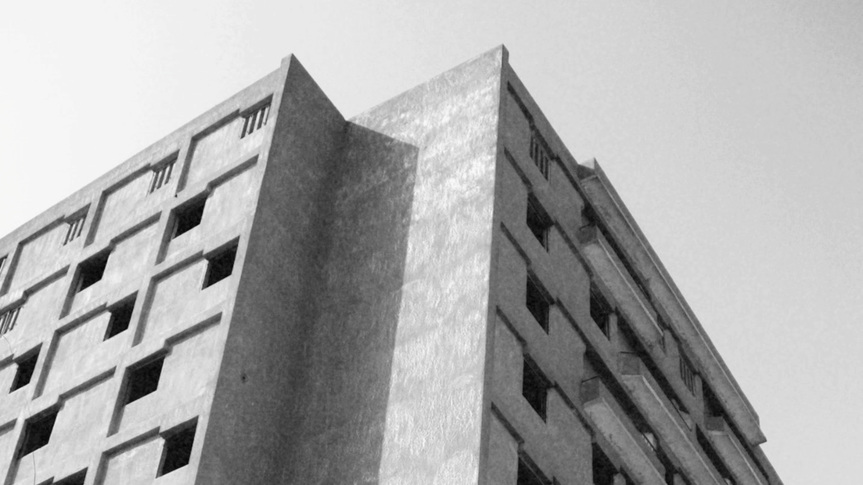-
From Current Issue
-
- Editor’s Letter Fire in the Heart
- Reviews I Gusti Ayu Kadek Murniasih
- Reviews 11th Seoul Mediacity Biennale: “One Escape at a Time”
- Dispatch Networked China
- One on One Monira Al Qadiri on Yukio Mishima
- Essays The rise of independent art spaces in pandemic-era Shanghai
- Features Tuan Andrew Nguyen
- Table of Contents
- Web Exclusives
- Archive
- Subscribe

R
E
V N
E
X
T
HEBA Y. AMIN, The General’s Stork I, 2020, archival color print, 100 × 80.9 cm. Courtesy the artist.
When Heba Y. Amin’s exhibition at The Mosaic Rooms, “When I see the future, I close my eyes,” reopened in May after a five-month lockdown closure, one of its projects gained fresh topical relevance in light of recent tensions between Israel and Gaza. Titled The General’s Stork (2013– ) and staged in a room painted pale pink, the work features large prints of the first aerial photographs of Palestine. These images were taken around 1900–1920 by members of the American Colony, a Christian Utopian society of pilgrims who immigrated to Jerusalem from the United States and Sweden. The Colony ran a profit-generating media department, which distributed photographs of the region to newspapers, books, and magazines around the world.
These aerial photographs notably depict Palestine as largely uninhabited land, feeding into the work’s anchoring question: how has aerial representation of the Middle East, especially those generated by the West, shaped popular and political understanding of the region in ways that accommodate imperial and settler-colonial exploits? The project was spurred by a news story in 2013 about a migratory stork that was detained by Egyptian authorities on suspicion of espionage (wrongfully, it turned out). For Amin, who was born in Cairo and is now based in Berlin, this incident was not just an absurd story of paranoia; rather, the paranoia was a symptom of larger forces. From here, the work evolved through research that fanned outward across time and disciplines, forming a critical examination of aerial-scopic regimes and their technologies, from land-surveying to drone surveillance and warfare. Amin’s method is often associative and playful. Here, comical portraits of General Edmund Allenby and his pet stork ties the 2013 incident to historical imperialist activity in the region. In 1917, Allenby led the British army’s successful capture of large swaths of Palestine from Ottoman control. Alongside more conventional military operations, Allenby is said to have sent planes over Jerusalem, showering the city with leaflets demanding the Ottomans’ surrender.
In such a manner, Amin’s multimedia practice creates illuminating constellations of histories and discourses that connect the Middle East with critique of today’s globalized world order. In Operation Sunken Sea (2018– ), a video installed in a darkened, windowless room shows Amin in the guise of a political figure delivering a speech. Looming over the podium in severe black attire, she proposes a “civilizing mission” to relocate the Mediterranean Sea within the African continent, claiming it would “solve” the migration crisis and liberate people from “the shackles of imperialism, from neoliberalism.” The speech, however, is cobbled together from authoritarian, imperialist rhetoric: the invocation of “human progress,” the promise of “freedom,” the megalomaniacal claim to “rewrite history.” Such rhetoric is echoed in the accompanying archival material, presented on a platform reminiscent of a grandiose conference table, which include newspaper clippings, journal articles, and declassified US Central Intelligence Agency papers that document real-life macro-engineering proposals from throughout the 20th century to alter the terrain of North Africa.
Where Operation offers a satirical, if heavy-handed, critique of techno-utopian propositions and their underlying political and commercial motives, a more subtle response to utopian optimism is offered in Project Speak2Tweet, an ongoing work begun in 2011, during the Arab Spring. When the Egyptian government shut down the internet in response to the popular uprising within the country, a group of programmers launched Speak2Tweet, a digital platform that allowed people to post voice recordings to Twitter. Here, the recordings play in a small room on eight TV monitors, paired with black-and-white footage of derelict buildings in Egypt, which, with the hindsight afforded to today’s viewer, tempers the revolutionary optimism of the recorded messages and questions the democratic potential attributed to social media technology. These messages are deeply moving, at moments devastating, but more striking is to hear them in polyphony: what made the uprisings of 2011 feel so powerful was that they managed, albeit briefly, to unify the efforts of groups with diverse ideological affiliations—secular, labor, Islamist. It is apt that the monitors are hung on steel framing, like those used in building work: for Egypt, a decade on, the road away from authoritarianism and sectarian strife remains a project under construction.
Heba Y. Amin’s “When I see the future, I close my eyes” was on view at The Mosaic Rooms, London, from October 1, 2020, to June 6, 2021.
To read more of ArtAsiaPacific’s articles, visit our Digital Library.













